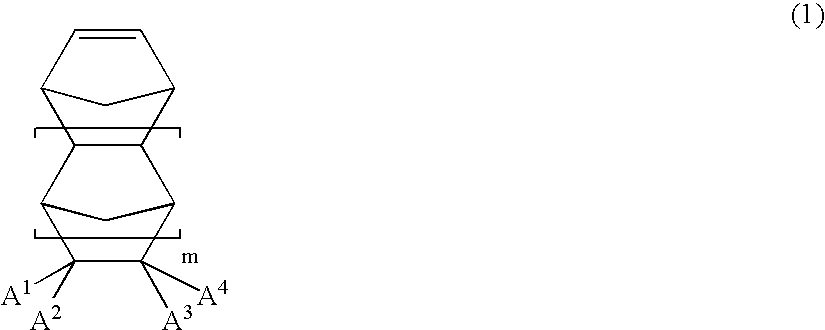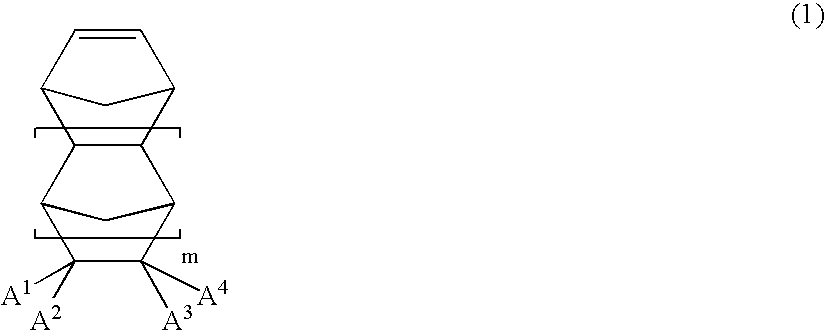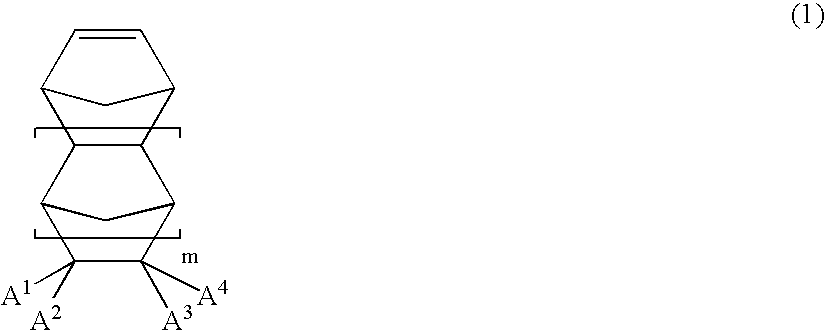Process for manufacturing cycloolefin addition polymer
a technology of cycloolefin and polymer, which is applied in the field of process for manufacturing cycloolefin addition polymer, can solve the problems of large amount of low molecular weight components, and achieve the effects of high polymerization conversion rate, excellent balance of processability and mechanical strength, and uniform quality
- Summary
- Abstract
- Description
- Claims
- Application Information
AI Technical Summary
Benefits of technology
Problems solved by technology
Method used
Image
Examples
example 1
[0239] A 20 1 stainless steel autoclave equipped with a jacket, of which the internal atmosphere was sufficiently replaced with nitrogen, was charged with 8.9 kg of toluene, 875 g (9.30 mol) of bicyclo[2.2.1]hept-2-ene and 1.07 kg (7.13 mol) of 5-butylbicyclo[2.2.1]hept-2-ene, dissolved in toluene. The pressure of nitrogen was increased to 0.05 MPa. Ethylene was introduced to make the partial pressure 0.0065 MPa while stirring, and the mixture was heated to 50° C.
[0240] 0.05 mmol of (tricyclopentylphosphine)palladium di(acetate) and 0.05 mmol of triphenylcarbeniumtetrakis(pentafluorophenyl)borate were respectively dissolved in toluene, and the solutions were added to the mixture to initiate polymerization. After confirming an increase in the internal temperature, cold water was circulated to control the temperature at 50±5° C. The conversion rate was determined by collecting samples from time to time. Additional monomers were supplied at conversion rates shown in Table 1. As a resu...
example 2
[0248] A 20 1 stainless steel autoclave equipped with a jacket, of which the internal atmosphere was sufficiently replaced with nitrogen, was charged with 8.7 kg of toluene, 902 g (9.59 mol) of bicyclo[2.2.1]hept-2-ene and 600 g (3.99 mol) of 5-butylbicyclo[2.2.1]hept-2-ene, dissolved in toluene. The pressure of nitrogen was increased to 0.05 MPa. Ethylene was introduced to make the partial pressure 0.0085 MPa while stirring, and the mixture was heated to 50° C. 0.053 mmol of (tricyclopentylphosphine)palladium di(acetate) and 0.053 mmol of triphenylcarbeniumtetrakis(pentafluorophenyl)borate were respectively dissolved in toluene, and the solutions were added to the mixture to initiate polymerization. After confirming an increase in the internal temperature, cold water was circulated to control the temperature at 50±5° C. The conversion rate was determined by collecting samples from time to time. Additional monomers were supplied at conversion rates shown in Table 4. As a result of c...
example 3
[0253] A 20 1 stainless steel autoclave equipped with a jacket, of which the internal atmosphere was sufficiently replaced with nitrogen, was charged with 8.7 kg of toluene and 915 g (9.72 mol) of bicyclo[2.2.1]hept-2-ene, 527 g (3.51 mol) of 5-butylbicyclo[2.2.1]hept-2-ene, and 83.3 g (0.39 mol) of 2-trimethoxysilylbicyclo[2.2.1]hept-5-ene dissolved in toluene. The pressure of nitrogen was increased to 0.05 MPa. Ethylene was introduced to make the partial pressure 0.0085 MPa while stirring, and the mixture was heated to 50° C. 0.054 mmol of (tricyclopentylphosphine)palladium di(acetate) and 0.054 mmol of triphenylcarbeniumtetrakis(pentafluorophenyl)borate were respectively dissolved in toluene, and the solutions were added to the mixture to initiate polymerization. After confirming an increase in the internal temperature, cold water was circulated to control the temperature at 50±5° C., and additional monomers were added at conversion rates shown in Table 5. As a result of continui...
PUM
| Property | Measurement | Unit |
|---|---|---|
| wt % | aaaaa | aaaaa |
| mol % | aaaaa | aaaaa |
| wt % | aaaaa | aaaaa |
Abstract
Description
Claims
Application Information
 Login to View More
Login to View More - R&D
- Intellectual Property
- Life Sciences
- Materials
- Tech Scout
- Unparalleled Data Quality
- Higher Quality Content
- 60% Fewer Hallucinations
Browse by: Latest US Patents, China's latest patents, Technical Efficacy Thesaurus, Application Domain, Technology Topic, Popular Technical Reports.
© 2025 PatSnap. All rights reserved.Legal|Privacy policy|Modern Slavery Act Transparency Statement|Sitemap|About US| Contact US: help@patsnap.com



